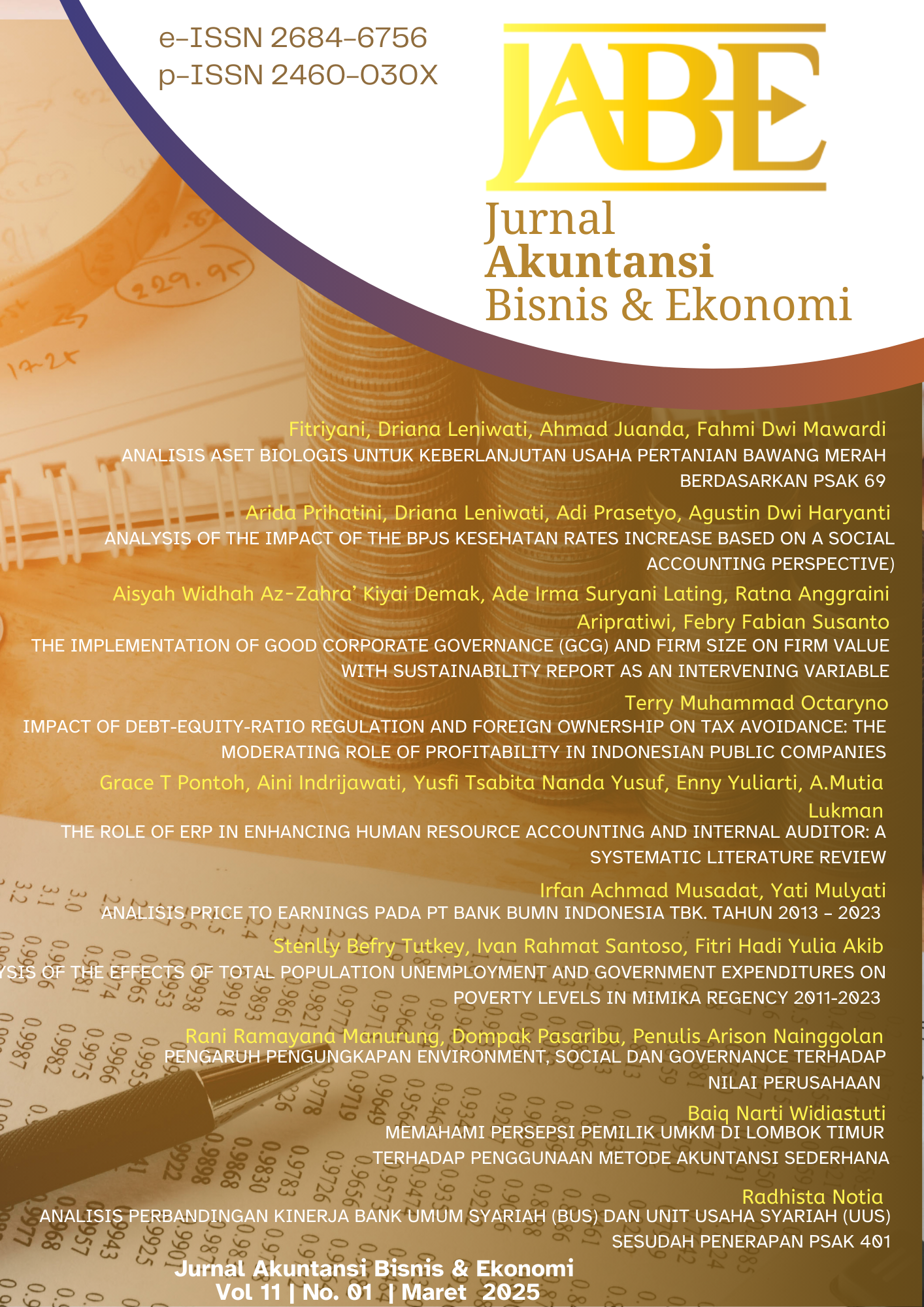Impact of Debt-Equity-Ratio Regulation and Foreign Ownership on Tax Avoidance: The Moderating Role of Profitability in Indonesian Public Companies
DOI:
https://doi.org/10.33197/jabe.vol11.iss1.2025.2403Keywords:
Tax Avoidance, DER Regulation, Foreign Ownership, ProfitabilityAbstract
This study examines the impact of debt-to-equity ratio (DER) regulation and foreign ownership on tax avoidance in Indonesian public companies, with profitability acting as a moderating variable. The sample includes companies listed on the Indonesia Stock Exchange that reported positive pre-tax and net income from 2011 to 2020. Using purposive sampling, the final dataset comprises 104 companies across six industrial sectors, averaged annually by sector, resulting in 60 data points. Data analysis was conducted using SPSS version 24. Findings reveal that DER regulation has a negative impact on tax avoidance, suggesting that higher DER values lead to greater creditor scrutiny, thus discouraging tax avoidance. This trend held consistent before and after the implementation of regulation PMK-169/2015. Conversely, foreign ownership positively influences tax avoidance, indicating that companies with higher foreign ownership levels tend to adopt tax avoidance strategies. Profitability, however, negatively moderates the foreign ownership-tax avoidance relationship, indicating that more profitable firms are less likely to engage in aggressive tax avoidance. This study underscores the importance of DER regulation in limiting tax avoidance and highlights profitability as a factor reducing tax avoidance in foreign-owned companies. Limitations include the study’s focus on six industry sectors and annual data, which may overlook intra-year variations. Future research could expand the scope by including additional sectors and quarterly data to capture short-term tax strategies, and by examining other moderating factors, such as firm size and market competitiveness.
Downloads
References
Ariyanti, F. (2021). 2.000 Perusahaan Asing Gelapkan Pajak Selama 10 Tahun. Retrieved from https://www.liputan6.com/bisnis/read/2469089/2000-perusahaan-asing-gelapkan-pajak-selama-10-tahun
BPS. (2024). Actual Government Expenditures (Finance) (Billion Rupiahs), 2022-2024. Retrieved from https://www.bps.go.id/en/statistics-table/2/MTA3MCMy/actual-government-revenues--billion-rupiahs-.html
Brigham, E. F. and H. J. F. (2017). Fundamentals of Financial Management: Concise, 9th Edition.
Chen, R. (2024). Multinational Tax Avoidance Associated with Leverage, Intangibility and Profitability on Non-US. Data.
Chen, S., Chen, X., Cheng, Q., & Shevlin, T. J. (2011). Are Family Firms More Tax Aggressive Than Non-Family Firms? SSRN Electronic Journal. https://doi.org/10.2139/ssrn.1014280
Christensen, T. E., Cottrell, D. M., & Budd, C. J. (2016). Advanced Financial Accounting.
CNN Indonesia. (2020). Studi: Penghindaran Pajak Rugikan Ekonomi Global Rp6.046 T. Retrieved fromhttps://www.cnnindonesia.com/ekonomi/20201120095447-532-572222/studi-penghindaran-pajak-rugikan-ekonomi-global-rp6046-t.
Darsani, P. A., & Sukartha, I. M. (2021). The Effect of Institutional Ownership, Profitability, Leverage and Capital Intensity Ratio on Tax Avoidance. In American Journal of Humanities and Social Sciences Research (Issue 5). www.ajhssr.com
Deef, A. T., Badi Alwarashdeh, & Nawaf Al-faerh. (2021). The Impact of Foreign Ownership and Managerial Ownership on Tax Avoidance: Empirical Evedence from Egypt. In Academy of Accounting and Financial Studies Journal (Vol. 25, Issue 2).
Desai, M. A., & Dharmapala, D. (2005). Corporate Tax Avoidance and Firm Value. SSRN Electronic Journal. https://doi.org/10.2139/ssrn.689562
Dom, R., Custers, A., Davenport, S., & Prichard, W. (2022). Innovations in Tax Compliance: Building Trust, Navigating Politics, and Tailoring Reform.
Duhoon, A., & Singh, M. (2023). Corporate tax avoidance: a systematic literature review and future research directions. LBS Journal of Management & Research, 21(2), 197–217. https://doi.org/10.1108/lbsjmr-12-2022-0082
Ekaristi, C. Y., Nur’aini F Purwienanti, E., & Rakhmayani, A. (2022). Analysis of the Effect of Profitability, Leverage on Tax Avoidance. In Applied International Journal.
Faradisa, F., & Fahlevi, H. (2022). Do Foreign Ownership, Profitability, and Leverage Influenece Tax Avoidance of Indonesian Mining Companies? Jurnal Ilmiah Mahasiswa Ekonomi Akuntansi, 7(4), 520–533. https://doi.org/10.24815/jimeka.v7i4.21100
Hanlon, M., & Heitzman, S. (2011). A Review of Tax Research. SSRN Electronic Journal. https://doi.org/10.2139/ssrn.1476561
Hargrave, M., & Abapo, S. R. (2023). Capital Structure Definition, Theories, & Example. https://study.com/academy/lesson/what-is-capital-structure-theory-definition-overview.html
Indriyanti, A and Pinondang Dalimunthe (2023). Profitability as a Moderator of Leverage and Firm Size on Tax Avoidance: Empirical Study at Indonesia Construction Companies. ECo-Fin, 5(3), 2023. https://doi.org/10.32877/ef
Jensen, M. C., & Meckling, W. H. (1976). Theory of the Firm: Managerial Behavior, Agency Costs and Ownership Structure. In Journal of Financial Economics (Issue 4). Harvard University Press.http://ssrn.com/abstract=94043Electroniccopyavailableat:http://ssrn.com/abstract=94043http://hupress.harvard.edu/catalog/JENTHF.html
Kompas.com. (2020). RI Diperkirakan Rugi Rp 68,7 Triliun Akibat Penghindaran Pajak. Retrieved from https://money.kompas.com/read/2020/11/23/183000126/ri-diperkirakan-rugi-rp-68-7-triliun-akibat-penghindaran-pajak?lgn_method=google&google_btn=onetap.
Mantiri, J. & W. U. (2024). Kepatuhan Pajak Perusahaan Terbuka Modal Asing Berdasarkan Laporan Keuangan Wajib Pajak. Indonesian Treasury Review
mediaindonesia.com. (2016). Perusahaan Mengaku Rugi tapi Terus Ekspansi. Retrieved from https://mediaindonesia.com/megapolitan/42193/perusahaan-mengaku-rugi-tapi-terus-ekspansi-1
Menkeu RI. (2015). PMK 169 Tahun 2015. www.jdih.kemenkeu.go.id
Mu’minah, L. L., Kristiana, I., & Hanum, A. N. (2023). The Role of Profitability in Moderating Political Connections, Corporate Risk, Leverage, And Firm Size to Tax Avoidance. Journal of Accounting Science, 7(1), 28–41. https://doi.org/10.21070/jas.v7i1.1681
Muhajirin, M. Y., Junaid, A., Arif, M., & Pramukti, A. (2021). Pengaruh Transfer Pricing dan Kepemilikan Asing Terhadap Tax Avodance Pada Perusahaan Manufaktur yang Terdaftar di Bursa Efek Indonesia (BEI). In Center of Economic Student Journal (Vol. 4, Issue 2).
Nafisah, K. (2016). Analisis Hukum tentang Kepemilikan Saham Asing. https://doi.org/10.12345/ius.v4i2.337
OECD. (2017). Limiting Base Erosion Involving Interest Deductions and Other Financial Payments, Action 4 - 2016 Update. OECD. https://doi.org/10.1787/9789264268333-en
OECD. (2024). Tax-to-GDP ratio. http://www.oecd.org/tax/tax-policy/oecd-classification-taxes-interpretative-guide.pdf
Olanisebe, Hannatu Sabo, Ahmad M, & Liman Muhammas M. (2023). Intitutional Ownership and Tax Avoidance of Listed Companies in Nigeria: The Mediating Effect of Profitability. In Fuoye. Journal of Accounting and Management (Vol. 6). https://www.firs.gov.ng/tax-statistics-report/
Ozili, P. K. (2023). The acceptable R-square in empirical modelling for social science research. Online at https://mpra.ub.uni-muenchen.de/115769/. MPRA Paper No. 115769, 26 Dec 2022
Prabowo, I. C. (2020). Capital Structure, Profitability, Firm Size and Corporate Tax Avoidance: Evidence from Indonesia Palm Oil Companies. Business Economic, Communication, and Social Science.
ProConsult. (2023). Kasus Penghindaran pajak perusahaan di Indonesia. Retrieved from https://proconsult.id/kasus-penghindaraan-pajak/
Pujiningsih, S., & Salsabyla, N. A. (2022). Relationship of Foreign Institutional Ownership and Management Incentives to Tax Avoidance. Jurnal Akuntansi Dan Keuangan Indonesia, 19(2), 244–262. https://doi.org/10.21002/jaki.2022.12
Rahayu, P., Suaidah, I., & Wahyuni, S. D. (2024). Can Foreign Ownership and Leverage Affect Tax Avoidance. Journal of Economics, Finance and Management Studies. https://doi.org/10.47191/jefms/v7-i4-43
Rahman, A., & Muktadir, Md. G. (2021). SPSS: An Imperative Quantitative Data Analysis Tool for Social Science Research. International Journal of Research and Innovation in Social Science, 05(10), 300–302. https://doi.org/10.47772/ijriss.2021.51012
Rego, S. Olhoft and, Wilson, R. (2012). Equity Risk Incentives and Corporate Tax Aggressiveness. In Journal of Accounting Research.
Riyanto, E. (2016). Indonesia’s new Thin Capitalisation rules. https://www.taxand.com/wp-content/uploads/2017/09/indonesias_new_thin_capitalisation_rules-1.pdf
Satyadini, A. E., Rea Erlangga, R., & Vdkg, B. S. (2019). Who Avoids Taxes? An Empirical Evidence from The Case of Indonesia.
Sekaran, U., & Bougie, R. (2016). Research Methods for Business. www.wileypluslearningspace.com
Shubita, M. F. (2024). The relationship between sales growth, profitability, and tax avoidance. Innovative Marketing, 20(1), 113–121. https://doi.org/10.21511/im.20(1).2024.10
Susilawati, E., & Tarmidi, D. (2024). The Influence of Institutional Ownership and Foreign Ownership on Tax Avoidance with Audit Quality as a Moderation Variable. Asian Journal of Economics, Business and Accounting, 24(5), 1–11. https://doi.org/10.9734/ajeba/2024/v24i51286
Tax Justice Network. (2023). State of Tax Justice 2023. https://taxjustice.net/reports/the-state-of-tax-justice-2023/
Wahlen, J. M.. Stephen Baginski, Mark Bradshaw. (2023). Financial Reporting, Financial Statement Analysis, and Valuation, 10e. Cengage Learning, Inc. ISBN:978-0-357-72209-1
Yustia, L., & Khomsiyah, K. (2024). Pengaruh Kepemilikan Asing, Direktur dan Komisaris Asing Terhadap Penghindaran Pajak dimoderasi oleh Profitabilitas. Ekonomis: Journal of Economics and Business, 8(1), 390. https://doi.org/10.33087/ekonomis.v8i1.1437
Zahwa Arinditya Putri, M., Mudzakir, A., & Islam, U. (2024). Pengaruh Return on Assets (ROA) dan Current Ratio (CR) terhadap Cash Effective Tax rate (CETR) pad Perusahaan yang Terfadftar di Indeks Saham Syariah Indonesia (ISSI) (Studi di PT Harum Energy Tbk Periode 2013-2022). https://doi.org/10.46306/vls.v4i2
Zarkasih, E. N., & Maryati, M. (2023). Pengaruh Profitabilitas, Transfer Pricing, dan Kepemilikan Asing Terhadap Tax Avoidance. Ratio: Reviu Akuntansi Kontemporer Indonesia, 4(1). https://doi.org/10.30595/ratio.v4i1.15567
Downloads
Published
How to Cite
Issue
Section
License
Copyright (c) 2025 Terry Octaryno

This work is licensed under a Creative Commons Attribution-NonCommercial-ShareAlike 4.0 International License.
Submission of a manuscript implies that the submitted work has not been published before (except as part of a thesis or report, or abstract); that it is not under consideration for publication elsewhere; that its publication has been approved by all co-authors. If and when the manuscript is accepted for publication, the author(s) still hold the copyright and retain publishing rights without restrictions. Authors or others are allowed to multiply the article as long as not for commercial purposes. For the new invention, authors are suggested to manage its patent before published. The license type is CC-BY-SA 4.0.












